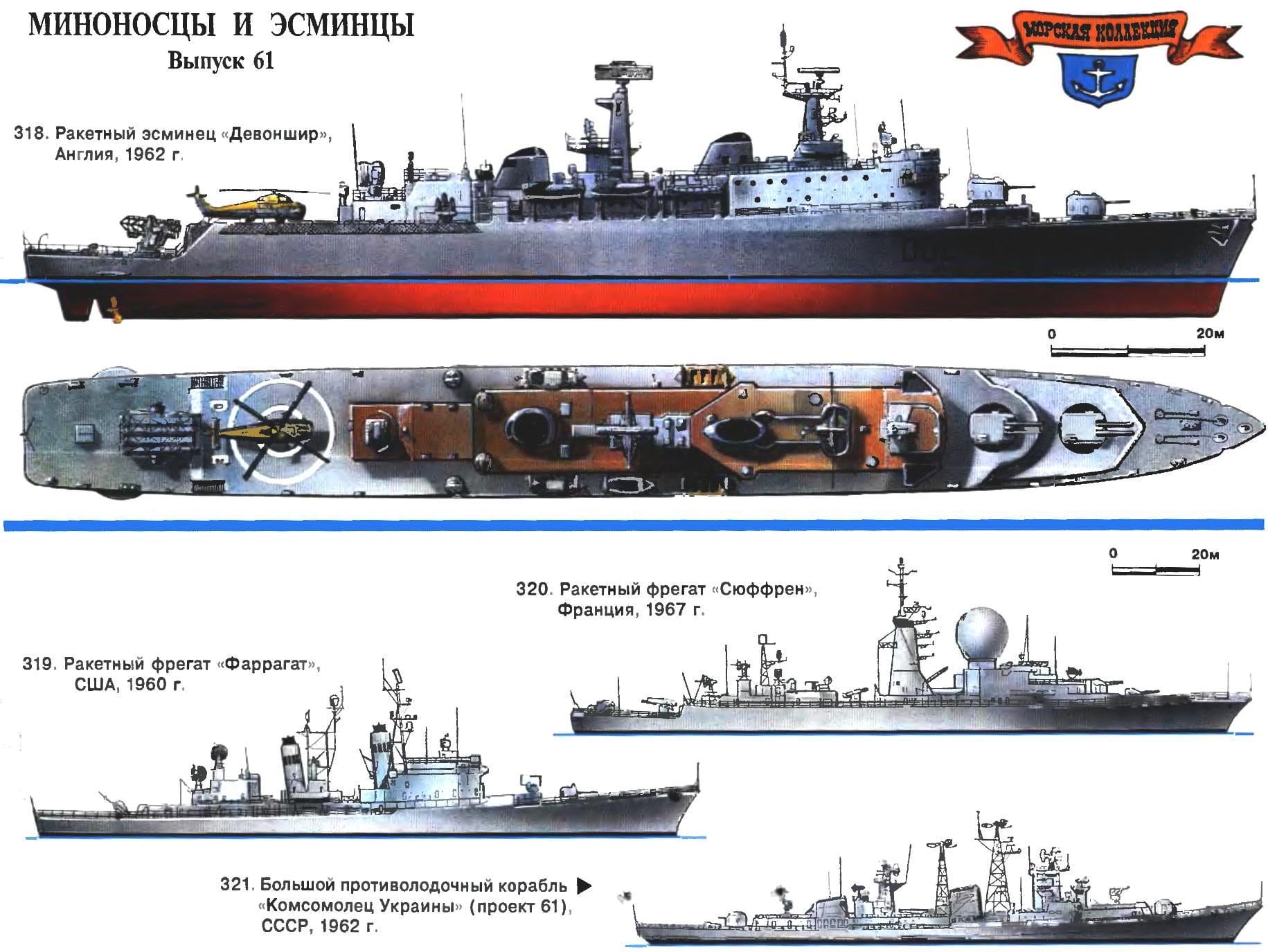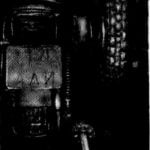However, if the first of the great defenders of the carriers (of the “Farragut”) architecture and armament represented an increased “Charles F. Adams” that the ships of the second series of the type “Legs” could be called destroyers only with a considerable degree of conditionality. And not only because of their torpedo armament was limited to traditional “small-bore” machines YC-32, and the artillery was reduced to four 76-mm guns — the rules of destroyers the beginning of the XX century. The new submarines displacement full load reached 7600 t and just a little bit not up to the size of light cruisers of world war II. Quite uncharacteristic of the destroyers was the case with the long forecastle — two missile launchers “Terrier” with its cellars and posts training simply does not fit in a flush-deck version. No wonder that, in 1975 when the Americans abolished the class guided missile frigates to destroyers carried only ships of the “Farragut,” and “Legi” and his followers type “Belknap” steel cruisers.
Initially anti-aircraft complex “Terrier” did not meet expectations, and at one time was supposed to completely re-equip created under it ships. But later came a more rational decision — has developed a new missile “Standard”. It is produced in single-stage and two-stage variants and completely replaced the Tartar and Terrier. At the same time installed the new electronics, which significantly increased the combat effectiveness of the ocean escort of the United States, and the replacement of the obsolete 76-millimetrovogo on anti-ship missiles “Harpoon” made “Legs” of the ship not only completely rocket, but also versatile, able to fend for themselves in a battle with enemy surface. The only thing he could do is support the troops for the landing. But the rich Americans for these purposes has always remained in stock pure artillery cruisers and even battleships. So missile frigates DLG as part of the Western naval doctrine had succeeded — in any case, at least theoretically.
But loyal allies — the British fared much worse. The postwar history of the British Navy became a long chain of compromises and retreats. With much effort, the lords of the Admiralty managed to “break” the first series of rocket ships, and they initially appeared as destroyer — all with the same goal to overcome the resistance of the Ministry of Finance and Parliament. In fact they were a European version of missile overseas leaders.
“County” in 1960-ies was amazingly similar to their ancient predecessors — the 10,000-ton heavy cruisers, also bore the names of counties of the United Kingdom. The same absurdly large body with high sides and just as obviously a bad concept. If “Washington tin”, which had very little protection and a modest performance, was built around their vospityvat, their namesake missile was designed solely as carriers of anti-aircraft system “sea Slag”. One look at the strange creature with its four boosters around the Central “trunk”, even looks a little reminiscent of the traditional rocket involuntarily raised doubts not only regarding its ability to get on a plane, but just to safely start. External absurdity, of course, did not prevent the British rocket to fly, but the unusual arrangement greatly complicates storage and all stages of preflight preparation. The situation was compounded by the very strange placement of the cellars. Despite the large free volumes, the British kept “si slay” in front of the cellar, where they through the entire ship served on special trolleys in a horizontal tunnel of substantial diameter. During this “campaign” missiles tested, installed control devices and stabilizers, and then they through a huge door in the slice of the forecastle finally came to the launcher. Because of the “binding” of the first stage boosters to launch had to use complex and heavy lattice design, compared with the starting device for XS. (In fairness it should be noted that Soviet aircraft-the shell was several times heavier.) In General, it is clear that the rate of such a system did not satisfy even the modest requirements of the first phase of the introduction of missile weapons. As compensation was assumed to have a launcher with three guides, but too much weight and the volume made be limited to only two, and in this regard, “County” was no better than their escort counterparts from other countries.
In addition to a range and medium-range missiles, the destroyers had a different, purely an English development, not having while analogues: installation of anti-aircraft short-range missiles “sea cat”.
A good idea was spoiled too primitive aiming system that required matching on one line of the missile and target in the optical sight during the entire flight time. A chance to get in modern high-speed aircraft, “C. katami” looked more than doubtful; an improved version of the complex was enough to keep the target in range of sight, and the differential calculator has calculated the optimal trajectory of the rocket. Been tested a traditional radar system, but its effectiveness remained low.
Of interest is that mechanical setup “County”, which included in addition to the usual combination of boilers and steam turbines, four gas turbines. The idea was that the cost of the steam turbine allowed to develop a decent cruising speed; their ships went most of his life. But in case of need quickly to move quickly or increase speed to full used GTU. Started on the “County” combined power plant has since been widely disseminated.
Among the other features of the project worth noting is the relatively decent for the time artillery armament, consisting of four 114-mm guns in two towers. However, this decision was forced: thus the British tried to compensate the not-too-high rate of fire their guns. Later on four ships in the series one of the towers gave way to French anti-ship Exocet missiles.
British missile destroyers first generation no famous service. Odplavam put two decades, five of them went abroad, and four units of reinforced fleet Chile, the traditional rival Argentina — shortly after the Falklands war. Among them were “Glamorgan”, “take the company” to support troops because of their 114-millimetrovogo (in one battle he got hit by an Argentine missile “Exocet” with the onshore installation and only miraculously did not go down).

318. Missile destroyer “Devonshire”, England, 1962
The lead ship of the type “County”. It was built by the firm “Cammel Laird”. The standard displacement of 5600 tons full 6800 T. maximum Length is 158.9 m, beam of 16.4 m and draft of 6.2 m. Capacity twin-shaft combined getprotobyname installation of 60,000 HP, a speed of 30 kt. Armament: coaxial installation, SURE “sea Slag”, two Quad launchers, SURE “sea cat”, four 114-mm universal guns, and two 20-mm machine gun, one helicopter. Just 1962-1970 years built 8 units. Currently 4 ships in the Navy of Chile.
319. Missile frigate “Farragut”, USA, 1960
Built by “Bethlehem”. The standard displacement of 4300 tons, T. 5650 full Length the greatest 156,3 m, width 15,9 m, draft 3.6 m, Capacity of two-shaft steam turbine 85 000 HP, speed 32 KTS. Armament: coaxial installation, SURE “Terrier”, one 127-mm universal automatic weapon, the complex PLURA “ASROCK”, two three-pipe 305-mm torpedo tubes ASW. Only in the years 1959-1961 built 10 units. Excluded from the lists of the fleet in 1989-1992.
320. Missile frigate “Suffren”, France, 1967
Built at the shipyard of the Navy in Brest. The standard displacement of 5050 tons, full 6090 T. maximum Length 157,6 m, width 15.5 m, draught 7,25 m. Capacity twin-shaft steam turbine 72 500 HP, speed 34 knots. Armament: coaxial installation, SURE “Mazurka”, two 100-mm universal automatic guns, four 20-mm machine gun, one launcher PLURA “Malafon” four canceller for anti-submarine torpedoes. Only the 1967-1970s built two units: “Suffren” and “Dukan”.
321. Large anti-submarine ship “Komsomolets Ukrainy” (project 61), USSR, 1962
It was built at the plant named after 61 Communards in Nikolaev. The standard displacement of 3400 tonnes, full 4390 T. maximum Length 144 m, beam 15,8 m, draft 4,6 m. Capacity twin-shaft gas turbine 72 000 HP, speed 34 knots. Armament: Daye paired launchers, SURE “Wave”, two twin 76-mm Arustamov key AK-726, one platetronic 533-mm torpedo tubes, four rocket-propelled mortars (2 RBU-6000 and RBU 2-1000). Just 1962-1972 was built 20 units, including one (“Discreet”) on improved project 61M (with four anti-ship missiles P-15M). One of the BOD series — “Brave” — in 1974, sank off the coast of the Crimea after the explosion of a missile in the cellar and fire.
The third Maritime power of the power of the West, France, trying to keep up with the Anglo-Saxons. In 1962 in Brest was founded “Suffren”, the first large guided missile destroyer, named for the American way a frigate with guided missiles (fregates lance-missiles). Two years later, followed by a second ship of the series, “duken”. As “Americans” and “Britons”, they were intended to accompany the aircraft carriers “Clemenceau” and “Foch” and protect them from submarine and air attacks. Big time construction (5-6 years) is associated mainly with refining weapons, especially anti-aircraft missiles of medium range “Mazurka”. The initial options suggested old-fashioned guidance of the radar beam, requiring constant tracking, but then managed to create more or less acceptable semi-active guidance system. The look of these destroyers are so distinctive that they are hard to confuse with any other combat ship. Huge Radome radar DRBI-23, and an equally massive mast pipe not turned them into beauties. But the French managed to achieve a good balance between anti-air and anti-submarine weapons components in your ocean “escorter”. Towed sonar variable depth of immersion in combination with missile complex “Malafon” was an acceptable chance to find and sink even a modern nuclear submarine. An interesting solution was used for the now obligatory anti-submarine torpedoes. They were produced from the four catapults-kickers, fixedly mounted in the superstructure in pairs on each side.
Originally intended to build a series of ocean-going destroyers, but these plans were ruined financial spadi excessive ambition. France put too much on creating your own underwater missile forces of strategic purpose, and the continuation of shipbuilding programs just don’t have enough money. But already built “duken” and “Suffren” are in order so far. In the course of modernization between 1977 and 1979, they received anti-ship missiles “Exocet” and after 12 years both ships have undergone a complete upgrade of electronic equipment which now corresponds to modern requirements. At the same time, they are additionally mounted two 20-mm machine — as a means of dealing with cruise missiles.
Well, what happened at this time on the other side of the “iron curtain”? The rapid development of the Soviet Navy in the 1950-ies came to the underwater threat. It turned out that no one type of warship is not able to effectively combat nuclear submarines. As is often the case, then there has been overlap in the other direction. At the initiative of the General Secretary N.With.Khrushchev began a massive write-down obsolete ships, including a completely new and even unfinished. To save at least part of a massive shipbuilding program, the Navy command of legislative procedure renamed all of the major combat units of the fleet in the large anti-submarine ships (BOD), although those often are not. A vivid example of the new policy was project 61, the first true missile ocean escort destroyer of the Soviet Union.
“Komsomolets of Ukraine” was smaller than their Western contemporaries of similar purpose on 1,5—2 thousand tons, but was armed with two highly advanced for its time, anti-aircraft missile complexes “Wave”. The main drawback of this robust and repeatedly modernizirovana missiles lack the necessary range. Under the protective “umbrella” only ships to the vicinity of his “guard”. In General, the project was exposed (exposed and still is) criticized for the weakness of the arms, although it is difficult to accept. A relatively small “61st” carried approximately the same number, “caliber” and purpose weapons, like the American “Legs”, and its location on a Soviet ship can be called close to perfect.
Exceptional innovation was the mechanical installation. For the first time in history on a large series of ships as main engines mounted gas turbines, which gave substantial savings in weight and capable of almost instantly increase the speed to maximum. “Komsomolets of Ukraine” could accelerate to cruising speed for 10 minutes and another 5 to give the full stroke. Even gas turbine generators. All this allowed to achieve excellent characteristics in mechanical twice easier install than on the predecessors of the 56th of the project.
Of course, anti-submarine armament remained weak. For multi-barreled rocket mortars RBU-series-6000 was not required of such a large vehicle; they can be place on ships three times less tonnage. Looked impressive located in the center of the housing platetronic torpedo, suitable for firing not only ASW, but also ordinary anti-ship torpedoes. Therefore, the domestic military analysts cleverly called the 61st ship, all the weaponry which is designed to protect the only offensive power — torpedo tubes.
However, the project deserves not only irony, but also great respect. According to the degree of rationality of construction and the saturation of weapons he stands out against their Western contemporaries. Another thing is that the ocean escort, in the form in which it was created, were not very popular in the Soviet Union. “Komsomolets of Ukraine” is much more suited to the Americans for support of numerous carrier battle groups. However, our first BOD for a long time and has worked on all the oceans until the 1990-ies, and one of the ships “Sharp-witted” — is in the fighting ranks of the black sea fleet to this day.
In conclusion, it is worth noting an interesting fact. All large escort ships beginning of 1960-ies, sooner or later, were armed with anti-ship missiles, turning them into “generalists”. This proves the depravity of the purely “protective” of specialization, so popular in those quite days.
V. KOFMAN
 In 1950-e years the Navy has a new enemy — jet aircraft. High speed and powerful weapons of new generation aircraft need to increase the range of their interception. But the first attempt to implement destroyers anti-aircraft missile systems, medium range as we already know have failed (see “modelist-Konstruktor” No. 9 for 2002). A two-stage Terrier with difficulty placed on the rebuilt “Hayate”, demanded too much space. Of course, the Americans could abandon its use, focusing on lighter single-stage “Tartarus”, but the desire to cover their carriers are far anti-aircraft “umbrella” gave rise to another solution. Times little space, so it is necessary to build larger ships! So there is a new subclass of destroyers, received in the USA the designation “missile frigates”, or “missile, the leaders of the destroyers” (DLG — Destroyer Leader, Guided Missile).
In 1950-e years the Navy has a new enemy — jet aircraft. High speed and powerful weapons of new generation aircraft need to increase the range of their interception. But the first attempt to implement destroyers anti-aircraft missile systems, medium range as we already know have failed (see “modelist-Konstruktor” No. 9 for 2002). A two-stage Terrier with difficulty placed on the rebuilt “Hayate”, demanded too much space. Of course, the Americans could abandon its use, focusing on lighter single-stage “Tartarus”, but the desire to cover their carriers are far anti-aircraft “umbrella” gave rise to another solution. Times little space, so it is necessary to build larger ships! So there is a new subclass of destroyers, received in the USA the designation “missile frigates”, or “missile, the leaders of the destroyers” (DLG — Destroyer Leader, Guided Missile).



